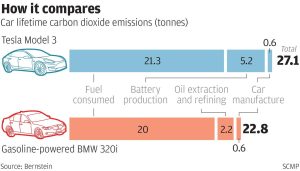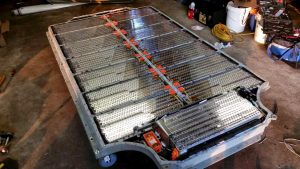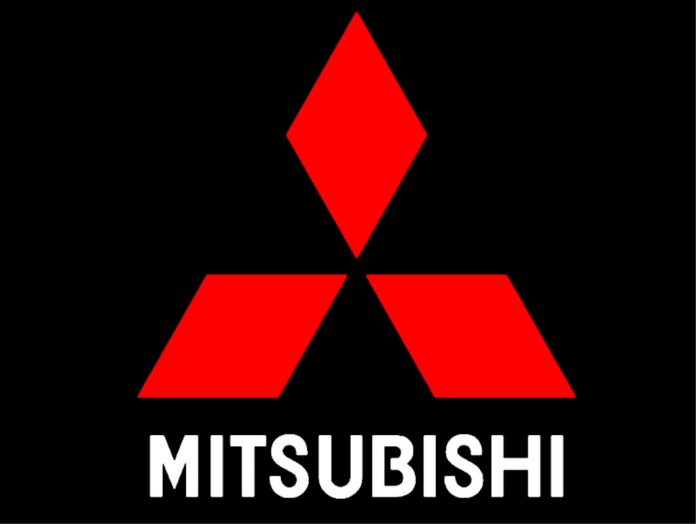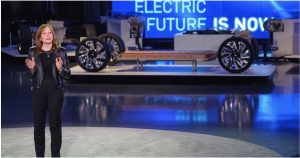An interesting thing that’s not being reported – by the usual suspects – is that Mitsubishi’s net profit hasn’t dropped by nearly half, as GM’s has.
It is interesting because Mitsu has had to deal with the same “supply chain disruptions” that supposedly contributed mightily to GM’s massive losses. Yet Mitsubishi just reported its quarterly profit has nearly tripled. It also posted the biggest short-term gains in six years. Including – and before – the “pandemic.”
Could it be that Mitsubishi – which has the smallest presence in the United States of any Japanese automaker – is the least Woke of all the automakers selling cars in the United States?
Mitsu sells affordable cars rather than electric cars. Cars like the Mirage, a five-door hatchback that stickers for $14,645 to start – which is less than half the price of a Chevy Bolt EV. It also weighs about 1,500 pounds less than a Chevy Bolt – which weighs close to two tons. Which is why it can travel close to 400 miles on the highway rather than the 259 miles the government says the Bolt can go. 
Before its driver has to stop – and wait – for 7.5 hours, to recharge it at home.
Not a single Mirage has gone up in smoke, either. A number of Bolts have. Some while parked. This sort of thing tends to be bad for the bottom line. But GM doubles down on virtue signaling rather than selling. More electric cars – electric crossovers, SUVs and trucks, actually – because GM no longer sells any cars, excepting its two specialty cars (Corvette and Camaro, the latter not for much longer).
Mitsu sells no electric vehicles. There is a hybrid version of its Outlander crossover SUV. But nothing that’s tethered by a cord to a long wait. Or a trip (to the “fast”) charger – followed by a wait, then a trip back home.
Mitsu’s focus is on affordable, practical cars – and crossovers. Exactly the kinds of cars and crossovers average Americans desperately need, having been deliberately impoverished by the things pushing electric cars, the “vaccines” of transportation. Both being unsafe and ineffective.
Affordable and practical cars like the Mirage are the antidote to these “vaccines.” Also, to the supposed “catastrophic threat” posed by a “changing climate” – the “change” never specifically defined in a way that can be factually supported. Just the same as the assertions made about the necessity – and efficacy – of “mask” wearing.
It just . . . “changes” – whatever that means. Which of course means anything and everything. It is a brilliant verbal stab at the heart of our civilization because of its very meaninglessness. Which is used to justify endless reductions in everything that makes civilization possible.
But if you do believe – just the right word – that the “climate” is “changing” in a “catastrophic” way, on account of our use of too much energy, resulting in the “emission” of too much carbon dioxide (the latter being a bizarre belief given the fact that the totality of the earth’s atmosphere contains less than half a percent C02 and our “emissions” constitute a fraction of that fraction; the equivalent of a burp in a stadium) then you ought to be very “concerned” about short-lived, energy-hogging electric cars.
A car such as the Mirage is made once, using relatively few raw materials – as compared with the massive quantity of raw materials that go into the making of an EV. Once made, it will last for 15-20 years before it needs to be replaced with another car, built from scratch, using more raw materials and energy to make it. The EV will have to be recycled long before then; its battery pack, at least. It – by itself – represents almost the same weight in raw materials as the Mirage, itself. And the raw materials that go into making it are very bad for the “environment.”
As far as the “climate”. . .
Well, the energy necessary to re-power all these EVs will require a massive increase in power generation, to provide it. Far more than is necessary – in italics to emphasize a very important point, if you are a believer in “climate change.”
Electric cars are energy hogs – an “inconvenient truth” that has been suppressed much the same as the truth about not-safe and ineffective “vaccines” that don’t “stop the spread,” because they do not immunize the victim.
EVs are equipped with battery packs twice as large as necessary – for transportation – that require twice as much in the way of raw materials – and energy inputs – so as to be capable of delivering the performance touted by the companies that make them.
If the “climate” really is in danger of “catastrophically changing,” how can something as frivolous – as unnecessary – as performance be indulged?
The answer is obvious. The “climate” isn’t “changing.” At least it is not “changing” in a “catastrophic” way on account of us driving. If it were, then this ramping up of performance electric cars while they try to eliminate (via regulations) low-cost, long-lived, low C02 “emitting” (in their totality) cars like the Mirage would be either an affront of almost epic irresponsibility or of equally epic stupidity.
It is one – of the other – for it cannot be anything other.
Kudos to Mitsu for doing something else.
Got a question about cars, Libertarian politics – or anything else? Click on the “ask Eric” link and send ’em in! Or email me at [email protected] if the @!** “ask Eric” button doesn’t work!
If you like what you’ve found here please consider supporting EPautos.
We depend on you to keep the wheels turning!
Our donate button is here.
If you prefer not to use PayPal, our mailing address is:
EPautos
721 Hummingbird Lane SE
Copper Hill, VA 24079
PS: Get an EPautos magnet or sticker or coaster in return for a $20 or more one-time donation or a $10 or more monthly recurring donation. (Please be sure to tell us you want a magnet or sticker or coaster – and also, provide an address, so we know where to mail the thing!)
My eBook about car buying (new and used) is also available for your favorite price – free! Click here. If that fails, email me at [email protected] and I will send you a copy directly!













Eric: A while back (a few years?) you had predicted the demise of Mitsubishi Motors, primarily due to their 0% and zero payments financing. (if I’m getting that right). Do you have any research or explanation as to why your prediction did not come to pass? Curious.
In Hawaii an economical Mirage will be way better option then an EV. EV’s are going to get a lot more expensive to charge there….lol
Hawaii Electricity Prices To Skyrocket As Final Shipment Of Coal Arrives
Hawaii is receiving its final shipment of coal this week, which Gov. David Ige called a huge step forward in the state’s transition to clean energy
Oahu residents should prepare to pay even more for electricity this fall. In other words, Europe’s catastrophic experience with the “Green transition” where an entire continent moved to “energy alternatives” some 30 years before it was ready to replace fossil fuels, is coming to at least one American state.
The Kapolei plant has been Oahu’s largest single generator for three decades, meeting about 16% of the island’s peak electricity demand. Its closure on Sept. 1 means eliminating 180 megawatts of power, or about one-tenth of what Oahu needs. There is no ready replacement for this source of energy which is about to go offline.
But wait, it gets funnier: one year ago, Hawaii was stunned to learn that the “green facility” which is replacing the Kapolei coal plant, the 185-MW Kapolei Energy Storage Facility, will be charging its “enormous battery” … with oil! In other words, Hawaiians will be trading one fossil fuel (coal) for another, albeit one far more expensive. Or as the chair of PUC, Jay Griffin, complained, Hawaiians are “going from cigarettes to crack.”
“If there is not enough solar, wind, or battery storage energy to replace the AES plant, HECO would have to use oil instead to charge things like the upcoming 185-megawatt Kapolei Energy Storage Facility,”
It’s not a matter of “if,” however. The reality is there’s not enough wind, solar, or battery storage to replace the AES plant.
Translation:another brilliantly executed “green” revolution, or as FEE put it:
The project is a wonderful demonstration of why we should be wary of giving central planners more power over energy security. It’s an example of a phenomenon explained by Ludwig von Mises: that government policies often have exactly the opposite effect of what was intended.
https://www.zerohedge.com/commodities/hawaii-electricity-prices-skyrocket-final-shipment-coal-arrives
from zh comments…..
It’s happening in Fort Pierce, FL too.
My electric tripled because we’re shipping US NatGas to the EU…and I’m paying for it.
Hawai is copying California in green insanity………
California is building the largest battery in the world near San Francisco, and they intend to power it from solar panels and windmills. They claim this is the ultimate in being ‘green,’ but it is not! This construction project is creating an environmental disaster. Let me tell you why.
The government has great solutions for the climate hoax……technology that is far more destructive to the environment…..
Lithium batteries:
Can’t be recycled = really green energy….haha
95% of lithium batteries aren’t recycled, Solar panels can’t be recycled, Used wind turbine blades can’t be recycled, Each blade weighs 81,000 pounds, they are made from fiberglass.
A typical EV battery weighs one thousand pounds, (tesla batteries go up to 1800 lb. ) It contains twenty-five pounds of lithium, sixty pounds of nickel, 44 pounds of manganese, 30 pounds cobalt, 200 pounds of copper, and 400 pounds of aluminum, steel, and plastic. Inside are over 6,000 individual lithium-ion cells.
It should concern you that all those toxic components come from mining. For instance, to manufacture each EV auto battery, you must process 25,000 pounds of brine for the lithium, 30,000 pounds of ore for the cobalt, 5,000 pounds of ore for the nickel, and 25,000 pounds of ore for copper. All told, you dig up 500,000 pounds of the earth’s crust for just one battery.”
Sixty-eight percent of the world’s cobalt, a significant part of a battery, comes from the Congo. Their mines have no pollution controls, and they employ children who die from handling this toxic material. Should we factor in these diseased kids as part of the cost of driving an electric car?”
95% of lithium batteries aren’t recycled
Solar panels:
The main problem with solar arrays is the chemicals needed to process silicate into the silicon used in the panels. To make pure enough silicon requires processing it with hydrochloric acid, sulfuric acid, nitric acid, hydrogen fluoride, trichloroethane, and acetone. In addition, they also need gallium, arsenide, copper-indium-gallium- diselenide, and cadmium-telluride, which also are highly toxic. Silicone dust is a hazard to the workers, and the panels cannot be recycled.
Solar panels can’t be recycled…..what will they do with them (and wind turbine blades)? throw them down old mine shafts like nuclear waste?…..lol..
solar panels are toxic. They sterilize the ground they sit on. Birds that fly over a solar farm are roasted mid-flight.
Have you researched the temperature directly above a solar farm?? These farms have been accused of creating warming in the regions around them.
The alarmists will always show you pictures of solar panels on green grass – which have to taken as soon as the panels are installed. They leach cadmium and other toxic chemicals and sterilize the soil. Just try to find anything growing under a solar farm that has stood for a few years.
And the landmass that both wind and solar take up will take up most of the farmland in America. Right now we’re not even at 3% electrical production of both. We’re going down a doomed path!
Wind turbines
Wind turbines are the ultimate in embedded costs and environmental destruction. Each weighs 1688 tons (the equivalent of 23 houses) and contains 1300 tons of concrete, 295 tons of steel, 48 tons of iron, 24 tons of fiberglass, and the hard to extract rare earths neodymium, praseodymium, and dysprosium. Each blade weighs 81,000 pounds and will last 15 to 20 years, at which time it must be replaced. We cannot recycle used blades. Sadly, both solar arrays and windmills kill birds, bats, sea life, and migratory insects.
Wind turbines are junk energy yes the cost is enormous! They have a lifespan of roughly maybe 20 years and to decommission one costs $500,000! And the landmass that both wind and solar take up will take up most of the farmland in America. Right now we’re not even at 3% electrical production of both. We’re going down a doomed path!
Used wind turbine blades can’t be recycled, Each blade weighs 81,000 pounds, they are made from fiberglass.
Wind turbines are junk energy yes the cost is enormous! They have a lifespan of roughly maybe 20 years and to decommission one costs $500,000!
they leak oil from their motors. They cannot be recycled so they are buried in Landfills. They use more electricity than they create. They can fling ice for hundreds of meters. They kill large predatory birds, bats and insects. Their infrasound negatively affect the hearts of humans and animals that live near them. The huge cement footings damage aquifers.
Well, most of the fun and games with Mitsu engines in MoPars back in the 80’s and 90’s was Mitsu’s doing.
Had a 1984 Veeger with a Mitsu 2.6L. The van engines had 2 valve per cylinder aluminum heads, and even though there was no MCA-Jet valve, they seemed to have trouble early on with head warping and cracking. My Veeger had a rebuilt head installed at about 50 K miles by the original owner, for example.
Those 2.6L’s in K-Cars had 3-valve-per-cylinder MCA-Jet aluminum heads. The third valve was in a steel cartridge, and gave trouble with head cracking and cartridge loosening, etc.
And yep, my Veeger was sold on at about 170K miles with a slapping timing chain, though there was no manual adjustment, only a hydraulic tensioner. That chain was VERY long, and IIRC, only a single-row bicycle type chain. That’s why they wore so much, that, and I suspect up north in the cold weather, if you didn’t change oil often enough, sludge would probably kill the tensioner early.
And the Mikuni 2-barrel monstrosity of an emission carb…been there, rebuilt that twice!
The Mitsu 3.0L V6’s also had their problems. Valve guide recession into the aluminum heads causing massive oil burning for one. Also, poor choice of valve seal material, causing hardening at less than 100 K miles and (you guessed it) massive oil burning. And, the water pump driven by the timing belt, and the rust-o-matic water tube under the intake manifold feeding the pump. Gotta pull the intake to fix the rusty leaking water tube.
Not that Ma MoPar learned much. Witness the 2.7L MoPar V6 and it’s “What in the DEVIL were they smoking when they designed THAT?” cooling “system”. Certainly not up to Slant 6 levels of reliability, any of them!
Thanks for the info. Looks like it took Mitsu a little longer to learn than Honda, guessing it was just a numbers game on units sold in the US.
The mid to late Honda CVCC engines had their share of alum. head problems among some smaller issues (remember the 50-60K MUST change timing belt?). Would blow the head gasket between 3 and 4 all the time. A lot.
Did my share of learning on them because my whole town bought them and I was the local shade tree mech., young and dumb, but whiling to give it a whirl, and I did. bought and sold 15-20+ hondas with troubles which paid for a lot of college.
A smart local Mech. shop hired me on as their Honda specialist to compete with the local shiester Honda dealer down the street. We did well and I made big money for a weekend warrior.
The owner begged me to stay on (even offered me to take over the biz) after I graduated from college but my parents would have killed me to throw away my edumication. A stayed on with him on weekends for years. Great dude and mentor of mine. Always wondered how life would have moved on for me if I had taken him up on it, as I was close to doing it and taking my lumps from my parents.
I don’t remember toyota having similar issues, but there was a fraction of them in our suburban town probably cause the dealer was much farther away.
I remember drooling over a Mitusbishi Eclupse back in the day. Talk about a design that aged well, check it out https://www.youtube.com/watch?v=Yuytoyl_JoI&ab_channel=LucasM
I drooled over the 80’s Starion. Never owned one though.
There are real environmental problems – plastics flooding the ocean,endrocrine disruptors in the environment. megafauna destruction, habitat loss, etc etc but fixing those problems don’t require hooking up a vacuum hose to the government teat like the endless black hole of made up climate change. What a world it would be without foreign boogeymen, central banks, and fake crises to bankrupt and panic the population. That meme of the laughoing lizards drinking cocktails is so correct.
Mitsubishi Motors, though part of a huge conglomerate, probably doesn’t have the money to waste on products that won’t sell. They are in the same boat as Chrysler which probably doesn’t have a huge R&D budget either. What money they have, they have to spend in on vehicles that will sell. Not electric vehicles that nobody wants.
It had that horrible electric i-MiEV car in the north American market (it’s still on sale in Europe and Asia). It of course didn’t sell very well.
The reality is the automakers have put themselves in a rock and a hard place. Instead of fighting the regulators they kicked the can down the road.
My guess is they plan on being rental (share) car businesses in the future once cars are too expensive to own. They likely (outside of government bailouts) won’t be in business long enough to get to that point.
The reality is that most people don’t want to “rent” or “share” cars because they either don’t want that due to the inconvenience or they won’t be able to afford it (it will never be cheap, it can’t be, due to uncle).
They double down on the rental idea due to making much more money as banks holding car loans than ACTUALLY BUILDING cars….. What would be better than loans that people can pay off when they can be replaced with rentals that never end?
I think some people are finally waking up to this, as the bad press with BMW wanting to charge people monthly for the seat heaters that are ALREADY installed in the car. BMW will likely back down this time, but not next time when they can hide it a bit.
good stuff rich. re: rental. I will fight it too. i don’t even borrow/rent from the bank anymore. makes me happy thinking about how much interest (all front loaded) i have saved over the years. trying to teach my kids about it. My oldest just bought another truck and did it cash, working.
Good! Although I’ve never owned one I’ve always liked Mitsubishi cars. They made a lot of really awesome whips in the past like the 3000gt. The Diamond Star motors venture with chrysler brought us the iconic Eclipse that lasted through many gorgeous generations. Hell, i even liked their old econobox the Dodge Colts as much as I like the current Mirage. One thing I don’t understand is the lack of market share for the Outlander given that it’s always looked great compared to most bland soccermom crossovers like the CRV. My former neighbor had a dark red 2015 Outlander sport and by looks alone you’d swear you could autocross the thing.
Lets hope the Japanese, with their lukewarm stance on EV’s, eat the competition alive. I’d be more than fine with less Euro/American/Korean junk rolling around. Most Japtraps can be kept on the road on the cheap for decades if you keep the rot out of ’em.
Thanks for the good word Eric. Made my day.
small economical cars?
how about the Peel P50 the world’s smallest car, it weighs 230 lb…..and gets 83 mpg, 68 mpg U.S…..one of them does 55 mph, great for around town……
This car is 100 x better then these 4000 lb EV abortions….lol
Plus, all these cars are US-legal and can be built as kits with buyer-provided engines.
build them and sell them, business opportunity….
https://www.motorbiscuit.com/a-smart-car-might-be-an-unexpectedly-great-daily-driver/
Mwhaha! Anon you’re something.
I’m all for small cars… Owned a fiero and a suzuki sidekick for over a decade. Love little econo rattletraps. But that p50… Whew! We could do way better than that if uncle scam would just bugger off. I was so excited for the Elio and original Aptera which both vanished and are now dangling the EV carrot like it’s an improvement. I’ve been keeping an eye out for a Gen1 manual insight. Even if the hybrid system goes kaput they can be engine swapped and still deliver over 50mpg due to their low weight and drag.
Hi CW
I just found out about the Peel P50, it is very cool, the ultimate minimalist car, 230 lb, original car was 132 lb. ….lol….a great tuner engine swap candidate…..import the kit and build one…..
Peel P50……one of the rarest cars in the World.
Narrower than a phone box & shorter than a Vespa, the P50 microcar is officially the World’s Smallest Car. The original cars weighed 132 lb….(new ones are 230 lb.) Made on the Isle of Man in the early 1960s, fewer than 30 exist today making it one of the rarest cars in the World.
Famously TV presenter Jeremy Clarkson drove a 1963 P50 through the BBC right up to his desk. It’s fame & rarity means cars often sell for over $170,000! Putting them out of reach of most car fans. Until now!
$170,000.00 should have bought one back then, they were $250 back then. That is appreciation like an air cooled 911….
Back in 1962, the Peel P50 was extremely cheap, even cheaper than a motorcycle, the BBC reports. It retailed for the equivalent of $250, which is about $2130 in today’s money. That’s less than even a new Honda Grom.
Today….soon the only car available will be a $50,000 lithium fire bomb EV….lol
Get a kit and build your own car…….
Gas/Petrol Kit
Complete kit less Engine
For 49 cc – 125 cc Engines
Stainless Steel Fuel Tank
Disc Brakes
Bodyshell in Standard Colours
Bespoke Paint & Trim Options Available
msrp:
£10,720* …….. $13,056 U.S.
https://p50cars.com
Peel P50 on bring a trailer
bid to $78,000 reserve not met…lol….no wonder, one sold for $170,000….Probably the highest value per pound ever?
Driving this at top speed is easier and safer than driving a McLaren at top speed. Plus the top speed is legal everywhere.
it has a clean Washington State title
https://bringatrailer.com/listing/1964-peel-p50/
from the bat comments:
I got the wonderful experience of driving this car in Seattle in March of this year. What a gas! It was quite simply unlike any other microcar I have driven as it is certainly the most micro of all micros. Driving in between parked cars in a parking lot means this car can travel on at least 10 times the amount of road than any other motorcar! LOL.
Please just take it easy on the cornering. Even though we were in an industrial park and off a main road, every car that did pass by immediately stopped with bewildered onlookers asking (A) WHAT IS THAT?!? (B) Is it okay if I take a picture? This is a rare and amazing artifact of 20th century automotive history never to be repeated again.
bewildered onlookers asking ….WHAT IS THAT?!?…driving a super 7 or 7 clone same response…….lol
Peel P50 $176,000
https://rmsothebys.com/en/auctions/am16/amelia-island/lots/r131-1964-peel-p50/175323
the original P50 weighed 132 lb. and got 100 mpg, and cost $250 ….perfect for today’s $5.00 gallon gas….
but today they are jamming 4000 lb., $50,000, lithium fire bomb EV’s down our throats that get 20.8 mpg…lol
somehow we went from 132 lb to 4000+ lb….lol….insanity…
Mitsubishit’s cars don’t seem to last too long- When’s the last time you saw an old one on the road? Not that they couldn’t…but they seem to cater to the bargain basement, and really, how much quality and durability can be expected of a car that sells new today for $14K- especially considering that several grand of that price is needed just to comply with Uncle’s edicts dictating all of the extraneous crap that new vehicles must be festooned with?
Not that they aren’t capable of making good stuff….. My tractor has a Mitsubishit engine -30 years old and still going strong! (I’ve had it for a dozen years and give it a good workout…and have never had one problem with it).
Hi Nunzio
The Best Four-Cylinder Engines Ever Built
Tracing its roots as far back as the early 1980s, the 2.0L 4G63 engines have truly withstood the test of time. The first turbocharged version of the engine, known as the 4G63T, was first seen in the 1998 Mitsubishi Galant VR-4.
This engine would go on to become the heartbeat of the Mitsubishi Lancer Evolution line of cars from 1992 to 2007, which would go on to dominate the World Rally Championships. Suffice to say, the 4G63T, through the Lancer Evo, would go on to define the brand for the greater part of two decades and also become the company’s most sought after sports car in both road-going and race-only configurations.
https://www.supercars.net/blog/best-4-cylinder-engines-ever-produced/
Agreed Anon.
People just treat cheap cars like throwaways and dump them when they finally fail. I hope people are getting over this notion that it’s not worth putting a $2000 engine in a $2000 car now that the prices new and used are just outrageous. So many good cars get junked because the cost of repair is higher than a monthly payment on a new and shiny 4-wheeled gadget. But if they’re dedicated to that lifestyle of new junk with monthly payments I guess it’s better for the junk pickers like me.
Anon,
“The “vaccines” of transportation. Both being unsafe and ineffective.”
Perfectly brilliant Eric.
Mitsubishi got a bad rep back when Chrysler was installing them, and it was not uncommon for them to go less than 50k before failing. Which could have been all Chrysler’s fault. I swallowed that bad rep, and haven’t had much interest in them since. They have made some of the most attractive cars for many years. Too bad they are all front wheel drive, including their “sports cars”.
**”Mitsubishi got a bad rep back when Chrysler was installing them,”**
So true, John!
I picked up a cheap Plymouth minivan years ago with a bad engine, to rebuild and re-sell. It had the Mitsubishit 2.6… What an abortion that thing was! It was relatively easy to rebuild, but the damn thing appeared to have been designed by Rube Goldberg! It had this long convoluted timing chain that ran everything, including two balancing shafts to make the engine run smooth.
The vast majority of them (including the one Im speaking of) would fail because hapless owners were clueless that adjusting timing chain tension (adjustable via a little doohickey that was easily accessible) on a rather regular basis was essential (A timing CHAIN that needs tension adjustment?!)- Any play in the chain would cause it to shave off aluminum shards from the LONG chain guides, which would in-tern clog the oiling system and or get into the internals…and poof! Most post-original owners were completely ignorant of this weird maintenance requirement (as were a good percentage of original owners).
They also had carburetors that were heated by engine coolant……and other weird things that made them prone to strange problems and premature failure. (Luckily, their diesel tractor engines are simple, with no weirdness, and bulletproof!)
Thanks Nunzio, makes sense on the chain adjust. issue. And it amazes me, how just a little thing like that can hurt a company for a long time. maybe they should have come up with a external fix (spring, oil pressure?) to fix them and maybe people would have given them a 2nd chance?
Learn something every day. wow.
I hope that Mitsu has it in their budget to bring back a proper evo in the future.
I highly doubt it, but even if it’s just an Evo X modernized a bit, I’d avoid the mistake I made in the past and get one
Depends on where you’re at, and which plant (or even shift) made your car. They’ve had on-and-off issues with paint before, but at least at the Normal, IL plant it was shift-specific QA problems. (My father was an engineer for them, and later for a supplier, and he’d actually run a VIN from a dealership to see which shift made it before he’d buy it.)
Part of the problem is that while they ran their ridiculous financing, selling to anyone with a pulse and underwriting those loans, a lot of Mitsus were sold to people who had neither the inclination nor the income to maintain the cars, nevermind purchase them responsibly, so a lot of the used Mitsus are totally clapped out from neglect and abuse, parked outside, dented and chipped, etc. It’s garnered them a partly-unfair reputation for poor longevity.
In other markets, like Australia for one, that hasn’t been so much an issue, and they have a reputation largely in line with other Japanese makes.
ATTENTION: This is really bad….Before the EV (with a 40 kWh battery) goes one foot the emissions/pollution just from manufacturing it equal to driving an ice diesel 89,400 km (50,550 miles), about 7 years driving.
“If an electric vehicle is using a 40 kWh battery (some EV’s have 90 kwh batteries which are 2.25 x as bad ), its embedded emissions from manufacturing would then be equivalent to the CO2 emissions caused by driving a diesel car with a fuel consumption of 5 litre per 100 km (about 55 mpg), up to 89,400 km (about 7 years average driving) before the electric car even has driven one meter,” Circular Energy reports.
The Bolt has a 66 kwh battery so is 1.65 times as enviromentally damaging ..Before the Bolt EV (with a 66 kWh battery) goes one foot the emissions/pollution just from manufacturing it equal to driving an ice diesel 147,500 km ( 91, 658 miles), about 10 years driving.
Then the battery dies in 10 years and you start over, another 89,400 km equivalent of pollution, (per 40 kwh battery), inflicted on the earth, just from the battery manufacture…lol….and it will only cost you $22,000…lol…
Bolt range:
What test drivers are actually getting driving in the real world driving EV’s is they are getting 2.4 miles of range for every kwh…..the bolt has a 66 kwh battery 2.4 miles x 66 kwh = 158 mile range…lol….in very cold weather -50% of that range = 79 miles…..lol
Ice diesel vs EV fuel economy comparison:
To go 100 miles the ice diesel burns 1.36 gallons of diesel in it’s super clean .000001% emission engine.
the EPA tells us that modern gas powered cars produce 98 – 99% less pollution than cars from the 1960s and 1970s. modern cars have .000001% emissions but that isn’t good enough they want zero, they are liars though, the new EV’s pollute more…lol
To go 100 miles the EV burns 43 lb of coal…… 43 lb of dirty coal were burnt to generate the electricity in the power station producing huge emissions destroying the environment.
ATTENTION: remember they are CEV’s Coal Electric Vehicles….
Plus the added bonus of a lithium fire bomb battery in the car….lol
ATTENTION: The Volkswagen Golf BlueMotion has emissions of 85g CO2 per km
A current-model large EV car emits about 88 grams of CO2 per kilometer,
Ice diesel:
The 2014 Volkswagen Golf BlueMotion diesel, capable of a claimed 88.3 mpg imperial, or 73.5 mpg U.S.
it has a 971 mile range, the perfect car.
The Volkswagen Golf BlueMotion has emissions of 85g CO2 per km. it is even cleaner (less emissions) than a Toyota Prius or an EV….
A bloomberg article states, “A current-model large EV car with a battery produced and charged in an average European Union country emits about 88 grams of CO2 per kilometer,
it weighs 1125 kg, 2480 lb, the new EV’s are over 4000 lb. it weighs 40% less.
EV
What test drivers are actually getting driving in the real world driving EV’s is they are getting 2.4 miles of range for every kwh
They are using 41.66 kwh to go 100 miles. (.4166 kwh per mile) = 83 mpg
ATTENTION: 83 mpg is based on electricity just coming out of a wall plug,
in reality 4.80 gallons of fuel or 43 lb of coal were burnt to generate the electricity in the power station = 20.8 mpg).
So to go 100 miles the EV burns 43 lb of coal
So to end up with 41.66 kwh of electricity which is equivalent to 1.20 gallons of gas to push the EV 100 miles down the road 4.80 gallons of fuel or 43 lb of coal were burnt to generate the electricity in the power station, remember net 25% efficiency. 100 miles using 4.80 gallons = 20.8 mpg,
New EV’s are over 4000 lb, that is why they get bad fuel economy. The 2014 Volkswagen Golf BlueMotion diesel weighs 40% less, helping it to get far greater fuel economy.
In the real world the EV with the large 90 kwh battery (some EV batteries are smaller) had only 216 mile range.
the 2014 Volkswagen Golf BlueMotion diesel has a 971 mile range.
Energy density:
In order to go 200 miles the EV had to carry around a 1000 lb battery (some tesla batteries weigh 1800 lb, the hummer battery is 3000 lb.)
In order to go 200 miles the 2014 Volkswagen Golf BlueMotion diesel had to only carry 9.52 lb of fuel.
There is the big difference the diesel ice car only had to carry 9.52 lb of fuel to go 200 miles the EV had to carry a 1000 lb battery, this has a huge effect on fuel economy
The 2014 Volkswagen Golf BlueMotion costs $24,355 U.S., EV’s start at about $45,000
there is a $20,000 incentive to buy the Volkswagen Golf BlueMotion…lol
20.8 mpg….lol…..these EV’s use more fuel so pollute more then ice vehicles
most new gas or diesel ice cars get better fuel economy, cost way less, use far fewer resources to manufacture, don’t have lithium fire bomb batteries, last three times as long as EV’s….
NOTE:
Thermal efficiency of power plants using coal, petroleum, natural gas or nuclear fuel and converting it to electricity are around 33% efficiency, natural gas is around 40%. Then there is average 6% loss in transmission, then there is a 5% loss in the charger, another 5% loss in the inverter, the electric motor is 90% efficient so another 10% loss before turning the electricity into mechanical power at the wheels.
33% – 6% – 5% – 5% – 10% = 25% efficiency for EV’s. In very cold weather EV’s are 12% efficient
a gallon of gas retains 100% of its chemical-kinetic-electrical energy potential throughout the entirety of its supply chain. This is extraordinarily effective when compared to electricity in either transmitted or battery-stored forms – which does not retain its potential and can lose from 15 to 45% of the generated kilowatt hours of electricity during the delivery and battery-charging/depletion/use processes.
……… instead of 26% loss (during delivery and use) this says it is up to a 45% loss
33% – 45% = 15% efficiency for EV’s. Then in very cold weather EV’s are 8% efficient..another 50% loss….
EV’s are looking pretty useless, they are being pushed on people through lying….
An EV just sitting loses:
tesla says a daily 3%-5% stationary range consumption.” (just parked)
So Tesla says it’s normal to fully discharge itself in under 3 weeks. Keep this in mind when parking it somewhere 90kwh @ $0.40 per kwh = another $36.00 per week loss just parked…lol
Plus the cost of the battery, which is huge, you have to store the electricity in the very, very expensive battery, that is the killer for EV’s right there, the expensive, rapidly wearing out battery.
the tesla $22,000 battery is used up, worn out in 100,000 miles.
ATTENTION: this works out to $22.00 per 100 miles it is costing you for the battery.
greens say burning 43 lb of coal to power their stupid EV is cleaner then burning 1.36 gallons of diesel in an ultra clean .0000001% emission ice diesel engine….lol….they have lied to everybody and got away with it….lol
https://www.caranddriver.com/news/a15118719/2014-volkswagen-golf-bluemotion-photos-and-info-auto-shows/
Mirage is the cleanest ice gas car, maybe that helps sales…..
Mitsubishi Mirage MPG (Fuel Consumption)
67.4 MPG (55 mpg U.S.) 4.2 litres/100km
Mirage CO2 output is 97.1 g/km
A current-model EV car emits about 88 grams of CO2 per kilometer, (electricity doesn’t come from a wall plug…lol…90% of electricity comes from burning hydrocarbons in a power plant.
But….Before the EV (with a 40 kWh battery) goes one foot the emissions/pollution just from manufacturing it equal to driving an ice diesel 89,400 km (50,550 miles), about 7 years driving.
“If an electric vehicle is using a 40 kWh battery (some EV’s have 90 kwh batteries which are 2.25 x as bad ), its embedded emissions from manufacturing would then be equivalent to the CO2 emissions caused by driving a diesel car with a fuel consumption of 5 litre per 100 km (about 55 mpg), up to 89,400 km (about 7 years average driving) before the electric car even has driven one meter,” Circular Energy reports.
The Bolt has a 66 kwh battery so is 1.65 times as enviromentally damaging ..Before the Bolt EV (with a 66 kWh battery) goes one foot the emissions/pollution just from manufacturing it equal to driving an ice diesel 147,500 km ( 91, 658 miles), about 10 years driving.
Then the battery dies in 10 years and you start over, another 89,400 km equivalent of pollution, (per 40 kwh battery), inflicted on the earth, just from the battery manufacture…lol….and it will only cost you $22,000…lol…(tesla battery price)
All YearsMitsubishi Mirage MPG 2013Mitsubishi Mirage MPG 2014 Mitsubishi Mirage MPG 2015Mitsubishi Mirage MPG 2016
What is the average MPG (fuel economy) of a Mitsubishi Mirage ?
Mitsubishi Mirage average fuel consumption is 67.4 MPG (55 mpg U.S.) or 4.2 litres/100km and average CO2 output is 97.1 g/km based on 14 models.
ATTENTION: The 2017 Mitsubishi Mirage and Mirage G4 consume less petroleum and produce less CO2 tailpipe emissions than all other subcompact vehicles with a gasoline engine.
Mirage curb weight 2095 lb.
A Bolt EV weighs 3589 lb ….Bolt is 1.71 x as heavy
https://car-emissions.com/cars/model/MITSUBISHI/Mirage
Mirage curb weight 2095 lb, very light 300 lb lighter then a Miata……great for an engine swap, 200 to 250 hp, it would fly, something very light and powerful…a VW 1.8 lt. 20vt swap sounds good……..maybe a Toyota engine….three cylinder, a 1.6-litre with 257bhp and 266lb ft…..lol
I’ve always wondered why Mitsubishi has not done as well as most Japanese car Manuf. in the US. Do you know? Seems that they have pretty big ups and downs, per my observation.
I think relevant is we sell packaged products for industry and over 20+ years of the same Mitsubishi products being used in these packages (as an OEM), we noticed that they stood well above the pack in reliability and value of their peers for that product category. So we looked into representing them for our market and were able to do so. We are very impressed with their products (for our industry) but not so much with their business practices. Not bad, but weird, and a little counterproductive. Maybe they have similar not-so-hot ‘business’ practices with the cars? It is not rare though, as many foreign manuf. have small issues doing biz in the US.
ChrisIN,
I think they just have their toes dipped in too many ponds to really compete with the other manufacturers. It seems like most of their car business has been partnerships with other auto manufacturers rather than focusing on building their own brand. Hell, my mothers ’12 Honda Fits alternator has a mitsubishi label on it, going 210k rustbelt miles strong.
Chris,
As I mentioned above, Mitsubishi got a bad rep for durability when Chrysler was using their engines, and they often failed at 50k. Or less. Which could easily, and likely be Chrysler’s fault.
That’s been somewhere around 30-40 years ago, but such things often stick in people’s minds, like mine.
Thanks CW and John, both make sense. I do remember the Mits engines in Chrysler stuff I just forgot, but I didn’t know they were not reliable or Chryslers application was bad. Thanks guys.